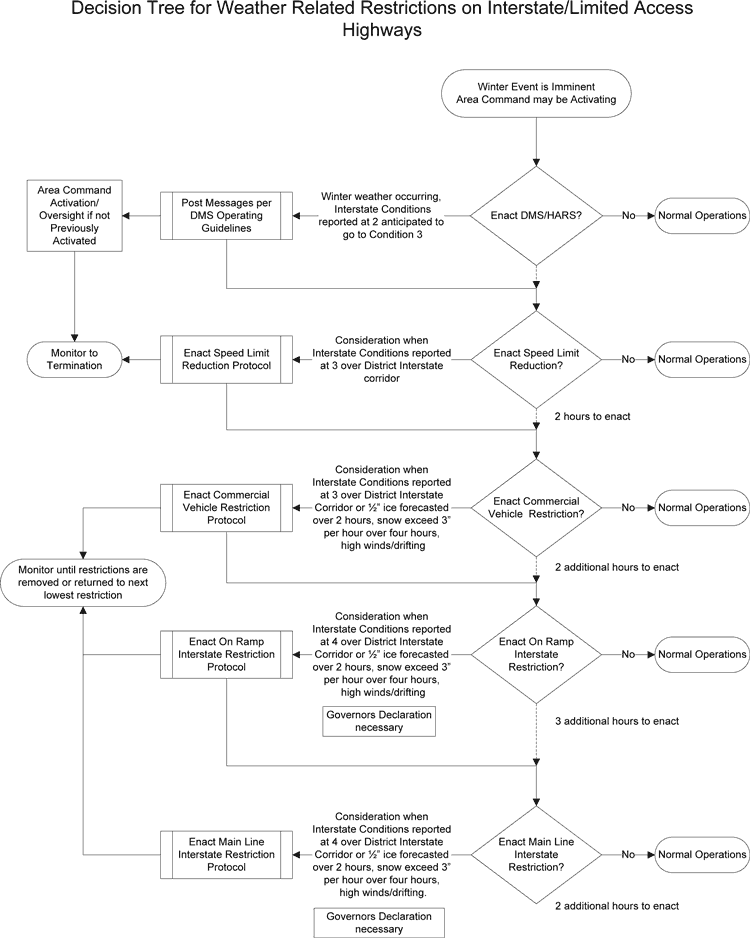Best Practices for Road Weather Management
Pennsylvania DOT Interstate Restriction System
In February 2007, a winter storm comprised of rain, ice and snow caused multiple accidents on Pennsylvania’s interstate highway. Twenty five percent of interstate routes were closed for extended periods of time. Many motorists were stranded along interstate corridors. Local and state resources were diverted from their primary duties during the storm to remove motorists from traffic queues and to manage detour routes. This combination of incidents prompted the Pennsylvania Department of Transportation (PennDOT) to deploy a management system for temporary speed restrictions and vehicle restrictions along the interstate. The goal of this effort is to reduce accidents stemming from inclement weather on the state’s limited access highways.
System Components: Pennsylvania’s interstate system is divided into regional geographic sections so only impacted sections of the interstate system are restricted in response to various weather conditions. The system was designed to utilize the state’s existing and planned ITS infrastructure, meaning it was “no cost” to implement. When the system is activated, PennDOT utilizes variable message signs, highway advisory radio, 511, local media, Twitter and e-mail notification to inform the traveling public and commercial vehicle operators of the restrictions. PennDOT intends to expand its means of notification through the use of various social media in 2012–13.
System Operations: The PennDOT Interstate Restriction system (Figure PA-1) consists of a managed plan to implement vehicle restrictions. The system is designed to increase and decrease restrictions as adverse weather conditions change. When certain weather conditions are reached, the first measure is triggered, warning motorists of winter road conditions. As conditions worsen, speed restrictions are imposed. Next, certain types of vehicles are barred from the interstate. If conditions are severe enough, eventually all interstate traffic is restricted.
(In Figure PA-1, Note that “Normal Operations” implies routine snow removal operations. If a restriction is not enacted, then standard snow removal operations continue. Also, the “Interstate Conditions” are defined as: 1—clear; 2—wet with freezing conditions; 3—snow and/or slush covered; 4—snow packed/significant snow cover; 5—icy; 6—impassable.)
During large-scale weather or “All-Hazard” emergencies, PennDOT operates under a uniform Incident Command System. The PennDOT Area Command center is located in the State Emergency Operations Center. Other representatives from impacted state agencies are also present. This coordination provides one location for coordinated incident response and planning between PennDOT, the Turnpike Commission, State Police, the National Guard and the State Emergency Management Agency.
At the onset of an inclement weather event, PennDOT provides advanced warning of hazardous road conditions through variable message signs and highway advisory radio. PennDOT Engineering District Incident Command Centers coordinate with the Area Command as weather conditions deteriorate on reduced speed limits and restrictions in the impacted region. Engineering District Incident Command Centers review road conditions, weather forecasts and traffic volumes to determine if additional restrictions are necessary. Forecasts of high winds, icing or blizzard conditions prompt planning for vehicle type restrictions and can lead to total interstate closures.
Figure PA-1. Interstate restriction flow chart.
Transportation Outcome(s): Historically, adverse weather accidents on the interstate involve large commercial motor vehicles, requiring lengthy closure times given the weather conditions. Critical resources are diverted to detour efforts or providing safety for motorists in the resulting traffic queue. The Interstate Restriction system has dramatically reduced vehicle accidents during inclement weather events. PennDOT’s Traffic Engineering and Highway Safety Division performed an engineering study and confirmed that in winter storms of equal magnitude fewer accidents occurred when 45 mph restrictions were in place. The reduction in accidents decreases traffic disruptions which allow PennDOT to efficiently continue maintenance operations on interstates. While the system was primarily developed for winter weather, speed limit reductions and specific commercial vehicle restrictions have been implemented successfully for high wind events like Hurricane Irene.
Implementation Issues: The primary implementation issue is providing adequate notification of interstate restrictions to the motoring public and in-transit commercial motor vehicle operators. PennDOT continues to expand Intelligent Transportation System (ITS) infrastructure, coordination with surrounding states’ Traffic Management Centers, 511 systems, and the use of social media to provide interstate restriction notification to motorists. Also, when implementing commercial motor vehicle restrictions, concerns with commercial vehicle parking have been identified. PennDOT is developing global diversion routes to provide restricted traffic with alternate routes of travel around restricted corridors. PennDOT continues to work with the Pennsylvania Motor Truck Association to provide advanced warning of interstate restrictions to facilitate their members’ dispatch planning.
Contact(s):
- Charles C Goodhart—PennDOT, Director, Bureau of Maintenance and Operations, 717-787-6899.
- Jason Norville—PennDOT, Section Chief, Winter Operations, 717-787-7004.
- Jonathan Fleming—PennDOT, Section Chief, Emergency and Incident Management, 717-772-1771.
Reference(s):
- Goodhart, C., “Lessons Learned and Next Steps to Effective Winter Storm Management,” presented at the 2010 National Rural ITS Conference, August 2010
Keywords: adverse weather, emergency management, weather information, speed limit restriction, incident management, traffic management, speed management, advisory speeds.
previous | next